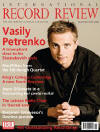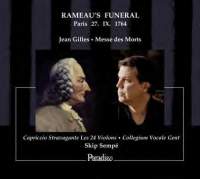Texte paru dans: / Appeared in:
*

International Record Review - (11//2014)
Pour
s'abonner / Subscription information
Paradizo
PA0013

Code-barres / Barcode
: 5425019972134 (ID486)
Consultez toutes les évaluations recensées pour ce cd
~~~~ Reach all the evaluations located for this CD
Jean‑Philippe Rameau's funeral was held in Paris on September 27th, 1764, 15 days after his death. His stature in France had been enormous, akin to that of Handel in England, and his funeral was suitably grand. The composers Corrette, Francoeur and Rebel ~the younger) took charge of the musical side of the ceremonies.. The composition at the heart of the funeral was the Messes des morts of Jean Gilles. Written 60 years earlier, this Requiem had become the staple for funerals of French composers, kings and other grandees. In his entertaining booklet essay, Skip Sempé tells us that its score was revised and modernized numerous times throughout the eighteenth century. Despite Corrette's shameless lie that the version performed at Rameau's memorial was 'just as the Author composed it', the 1764 version is very different from that first heard at Gilles's own funeral back in 1705. New movements were added (one, oddly, based on an aria by the Italian composer Domenico Alberti); extracts from Rameau's operas set to Latin texts were inserted; and the instrumentation was expanded to include horns, oboes, bassoons, double bass (scarcely known in France in 1705), timpani with mutes and a carillon to imitate church bells. It also appears ‑ although the notes are not entirely clear on this ‑ that orchestral movements by Rameau were also performed, as they are on this recording.
The substantial revisions to Gilles's masterpiece do not represent an improvement. The original had a sublime and austere greatness that is somewhat swamped in the Corrette/Francoeur/Rebel arrangement. Reflecting the changing sensibilities in France from 1705 to 1765, a dignified and profoundly religious grief in Gilles's fairly intimate original became grander, more secular and overtly emotional in the updated version. The shift was from an essentially theological understanding of the purpose of a Requiem (seeking mercy for a departed sinner) to one that is closer to the common modern funeral convention of feeling sad and memorializing a life. Nonetheless, there is still enormous strength in the music and it is undeniably affecting. Sempé quotes the Mercure de France of October 1764: 'We witnessed that many people could not keep back their tears during the Kyrie Eleison of the Mass, adapted from the expressive music of one of the most beautiful passages of Rameau's works.'
Gilles's Messe des morts suffered further indignities after 1764. An 1805 edition by Joseph Supries added more wind instruments, including clarinets. These were not enough for Abbé Jean Prim, who, as recently as 1956, took the 1764 version by Corrette et al and bloated it with still more woodwinds, horns and trumpets. This soon became the 'standard' version of the Mass.
This reconstruction brings together the fine Belgian choir Collegium Vocale Gent (without its conductor Philippe Herreweghe) and the orchestra Capriccio Stravagante Les 24 Violons, all led by Sempé in a live recording from Sint Walburgakerk in Bruges. The performance took place about four months shy of the 250th anniversary of Rameau's funeral. I understand that the same programme was performed on September 17th and 18th, 2014 in the Oratoire du Louvre in Paris, where the original funeral took place. Despite the lack of audience applause or other noise (no complaints on that score), this recording has a real sense of occasion. The Church of St Walburga is a beautiful building with a Baroque exterior and a largely neo‑classical interior. It is certainly of suitable vintage for Rameau's era. One imagines that attending this performance would have been an extraordinary experience.
On disc, however, the sound is distant and diffuse. It is flattering neither to voices nor instruments and this probably explains why both Collegium Vocale and Capriccio Stravagante seem slightly less crisply articulated than usual. Nonetheless, both groups are impeccably stylish and as accomplished as ever. The overall effect is of sumptuous richness, not absolute precision. The quality of solo singing is variable and, again, some allowance should be made for the acoustic. The bass Lisandro Abadie and tenor Juan Sancho are the strongest singers: pleasant in tone and stylistically aware. Haute‑contre Robert Getchell never seems to find a register that is entirely comfortable ‑ but this is something of an occupational hazard for that distinctly French voice type, which lies between a tenor and a countertenor. Soprano Judith van Wanroij seems somewhat out of place in this music. I suspect she would be more at home with music from 1864.
However, this disc is
certainly a highlight of Rameau's anniversary year, which has not received
as much attention as it should. Rameau enthusiasts should relish this disc;
Gilles purists may want to steer clear.
Cliquez l'un ou l'autre
bouton pour découvrir bien d'autres critiques de CD
Click either button for many other reviews


